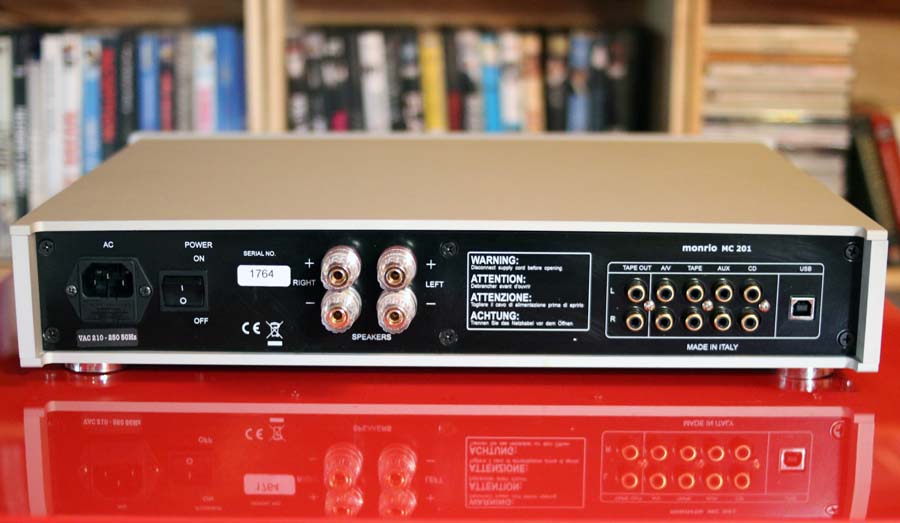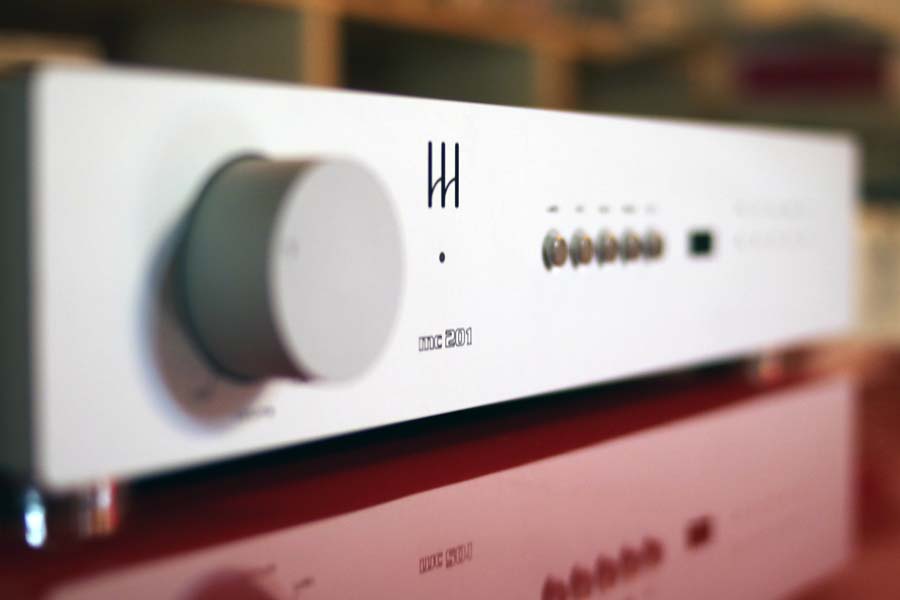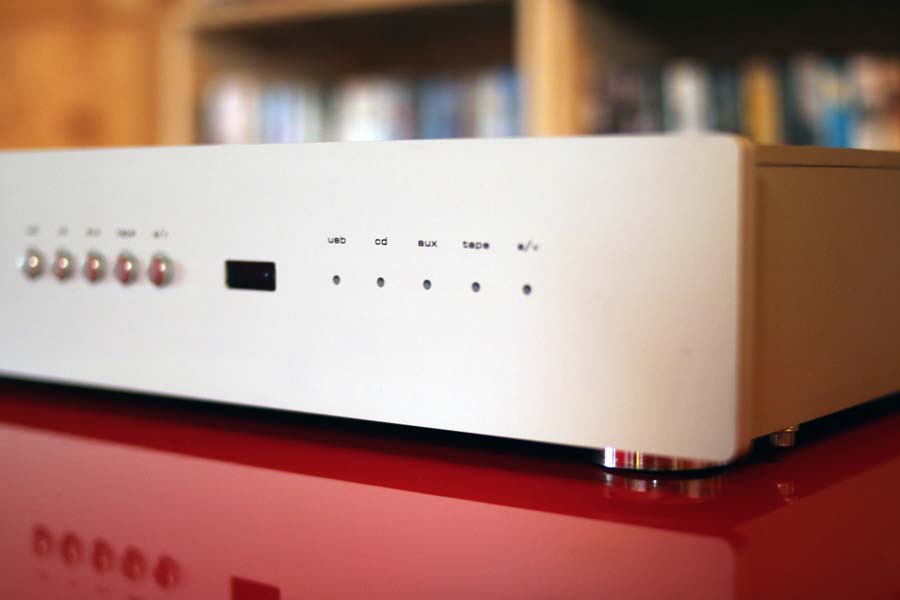I was really pleased to receive a call from Italian brand Monrio a few months ago asking if we’d be interested in reviewing one of their amplifiers as I’d owned one of their preamplifiers many years ago and thoroughly enjoyed it. Here we take a listen to the company’s MC 201 integrated amp with onboard USB DAC and costing £1600.
 BUILD AND FEATURES
BUILD AND FEATURES
The MC 201 has 5 total inputs, 4 analogue RCAs, 1 digital, plus, unusually these days, a tape loop. The digital input is via USB and so the MC201 makes adding a computer to your set-up a doddle. The onboard DAC is an AKM DAC, 24-bit/192 kHz that will handle WMA, MP3 Streams, MMS Playlists (M3U, PLS), MP3, AAC (up to 320 kbps, CBR/VBR) WAV and FLAC so pretty much all your files other than DSDs and super hi-res are catered for. It also includes a “direct” analogue input bypass that allows the use of the MC 201 in a home theatre system as a two-channel surround system. In addition to the inputs outlined above you have a set of good quality binding posts, the IEC input and a master power switch. There’s plenty of room around the back and everything is neatly laid out. Output is 60 Watts into 8 ohms.
Moving round to the front of the MC 201 the brushed aluminium front panel is likewise nicely laid out with input selector buttons, a small window for the remote to work and five blue LED indicators to let you know what source is selected. To the left of the front panel is the volume control which is nice and smooth in operation. The remote is a cheap, but move up the food chain in the Monrio range and I’m told you get nicely finished matching remotes, and these are also available for the MC201 but add 90 Euros to the cost, something I would definitely seriously consider.
Build quality is impressive with the unit weighing in at 10 Kg and the whole thing feels well put together and solid.
All in all, the Monrio is an unassuming but elegant unit that has gone for an understated design that looks great on the rack. It’s certainly no “look at me, look at me” amp and that inspires a degree of confidence in it.
SOUND QUALITY
I paired this amp with the now reference speaker in the circa £2500 price bracket, a dedicated computer running JPlay and Tidal, and a Leema Elements CD player (both with and without the mid-price reference DAC).
First up the digital USB input (no other digital inputs are catered for) and it really is a doddle; plug the USB cable into the back of the amp, then into the computer and the computer (running Windows 10) sees the DAC immediately. I had no drivers to install at all which surprised me somewhat. Nothing left to do than fire up Tidal Hifi and we’re listening to tunes. To be exact we’re listening to Deep Purple’s Made In Japan. I use this album a fair bit when evaluating new kit much to the consternation of the cats but I make no apologies to either readers nor the cats…who went and hid. I give it a while to get accustomed to the music and putting pen to paper and it’s not until The Mule that I start to take note. There is a drum solo in this track (OK, the track is pretty much a drum solo) and the Monrio copes very well indeed with what can be a difficult track to get right – it is fast, dynamic and responsive. As well as being nimble on its toes this is not at the sacrifice of good tonality with the amp bringing out good definition of each of the different drums with each hit being identifiable in the mix from the previous and next as Ian Paice moves around the drum kit. There is also good definition as the beater hits the skin of the bass drum. The positioning of individual drums around the kit is also good with each having its own space in the stereo image. Moving back to Child In Time, a track where Ian Gillan’s voice can sound somewhat shrill (the cat’s really don’t like it) and over the top, but towards the start of the track there is a few lines where his voice is delicate and subdued and the Monrio allows his delicacy before he opens up the throttle and really goes for it. Here it is good to hear the Monrio stay in control without over-playing it and allowing it to become a screeching noise that I have heard sound terrible in the past.
Remember here we are listening to the amp in conjunction with it’s onboard DAC and I reckon it to be a sympathetic partnering – it’s simple to set up and it sounds great. Therre s a definite lack of grain and coarseness in the higher frequencies and, as demonstrated on Natalie Merchant’s Ladybird, a slightly warm yet accurate feel to the midrange rendering her voice honey rich and smooth. This may suggest that the Monrio is somehow adding warmth and smoothing things off around the edges but there’s still depth of accuracy and tonality to her voice allowing you really to connect with what she is singing. Perhaps one criticism here is that whilst the left to right image in the stereo mix is impressive, the three-dimensional aspect, the way in which the music is projected out into the room forward and backwards, is not as good as the Thor Merrills we have used in this system. With that said when the next tune comes on (Maggie Said) I just don’t give a damn as Merchant’s tone and emotion come flooding through and there’s that emotional connection to the music that in my opinion is the key to great Hifi.
Monrio makes the following statement on their website about the MC201 “Radio station and compressed MP3 files take on new flavour through the MC 201” and so it would be remiss of me not to check this claim out. I’ll be honest and say that on all our systems MP3s are unlistenable and I only have a few handfuls that have been previously sent to me for review purposes…and they rarely get an outing. First up is Radio 4 (UK based speech radio) streamed via a 4G connection and at 128kbs MP3 and through the computer and into the Monrio via the USB – just for clarification. Radio 4 sounded OK, certainly better than in the car and there was a decent sense of the people speaking on The Money Program moving around the house they were in, but I’d not go as far as to say it had a “new flavour”. However, it was not unlistenable and I actually got quite into the program. Switching to Elekfantz’ Dark Tales and Love Songs is a whole different kettle of fish and I really do think that Monrio’s comment is doing them a disservice. They are suggesting that their DAC and amp combo somehow make the unlistenable listenable, but I’m afraid they are wrong…to a fair extent. Elekfantz album is still clearly MP3 but it’s not terrible on the Monrio. However, switching to Vermont’s eponymous album and things take a turn for the worse. There is a lot of synthesized higher frequencies on this record and it’s all but unlistenable (I got two tracks in before it got painful). The horrible graininess and harsh (digital) sound are still apparent and there is still the feeling that you are listening to something that is not “whole”. We have a saying that is apt here “You cannot make a silk purse out of a sow’s ear” and whatever the claims with regards to MP3s played through the MC201 made by Monrio, I do not agree with them. I got two tracks in on the Vermont record before giving up in despair as to how folk can accept MP3s (often stolen) as a main source of music. With that said, the speech program (at a terrible Bit-rate) was acceptable and the more middy Elekfantz album tolerable…just.
So far we’ve been listening to tunes on the Monrio’s onboard DAC which adds great convenience for those wanting to add a computer to their setup without wanting to go the whole digital hog. The DAC doesn’t allow for any other inputs other than USB and to some this may seem an oversight on Monrio’s behalf, but to my mind it’s actually fairly sensible as it keeps everything simple and it works well enough at what it does, especially when you are using higher resolution files. Would I say the DAC is the last word in resolution when compared to our reference, then no, and I’ll expand on that a little in the following few paragraphs.
The reference DAC (for this system) is now in place and Eels’ Beautiful Freak carries more authority, more detail, better forward to back dimensionality and overall a more “audiophile”-feel to proceedings. Spatiality (is that really a word?) is better than before and things seem to go lower and higher in every respect without losing it – and so it should, we’re talking about a DAC that was in excess of £5000 when new which is more than double the whole of the Monrio package, making the latter suddenly seem like a pretty good deal. But then the MC201 has to deal with the audio signal it is being fed and make sense of it and feed it coherently to the speakers and it does so wonderfully.
Overall the Monrio is a nicely balanced amplifier that has a sonic signature that I would suggest errs slightly on the warmer side of neutral in the mid-band making for an extremely non-fatiguing listen that will appeal to many. It has great control at the top and bottom of the frequency extremes and I genuinely don’t think it is out of place with a DAC/CD combo costing much more than the sum of its’ own parts.
Jorma Kaukonen’s Genesis (a great record – go buy it!) sounds just fantastic and it plays to the MC201’s strengths. Representation of the guitar is etched before you and that vocal is really beautifully projected into the room and never feels to be strained at any of the frequencies. I’ve noticed that I tend to like to listen to this record pretty loud but I just don’t feel the need with the MC201 in place. Strings ebb and flow and what’s more (and perhaps most importantly) is that emotional connection to the music that is playing without me wanting to over-evaluate or analyse.
CONCLUSION
I have a small admission to make; when I was reviewing this unit I had thought that the conversation I had had with Giovanni had mentioned a price of nearer €3000 for the MC201 and it was only after writing this that he confirmed price to be €1780.
As a standalone integrated amplifier, the Monrio is a lovely sounding amp that I have thoroughly enjoyed my time with. It errs on the side of warm and features mid-band frequencies really beautifully. However, this is not at the expense of detail and grip in the other frequency extremes. For those looking for an absolutely neutral amplifier then I suggest you would be better served elsewhere, but that is not to say that the MC201 will not find its fans looking to simply enjoy their music collection in a really connected (emotionally) manner.
The onboard DAC is a useful addition and whilst it is not the last word in definition it allows for the simple and stress-free addition of a computer to a system. The Monrio website seems to claim it will make poor online streams and MP3 content sound better, but I don’t agree.
Build quality, apart from the remote control, is of a very high standard and the unit should be fit and forget for many.
AT A GLANCE
Build Quality: Great build both inside and out (I did ask permission before opening up) with casework that puts many costlier amps to shame. Remote is not in keeping with the product’s build and quality and so factor in an extra €90 for the matching one in aluminium.
Sound Quality: Warm and yet detailed unfatiguing presentation with great control of bass.
Value For Money: Given the features and build, allied with a lovely sound, I believe the price to be very good value, even when you factor in the price of the upgraded remote.
Pros: The onboard DAC is a very useful addition for those wanting to add a computer to their system but not to “go mad” on the digital front. Beautiful mid-band quality exuding clarity and warmth and with good on the loudspeakers’ response. A very non-fatiguing listen with lovely connection to the music.
Cons: The remote isn’t great for this level of product. The onboard DAC is USB only (though that could be seen as a positive). Not as three dimensional when using the onboard DAC as when using our better (and much costlier) reference DAC. Some may not like the slightly warmer signature. Onboard DAC won’t make MP3s sound better as claimed.
Price: €1780 or £1600. Upgraded Remote €90.
Stuart Smith
Review Equipment: Leema Acoustics Elements CD, VAD DAC, Windows computer running Tidal and J Play, Xavian Perla speakers. Cables by Chord Cables, Tellurium Q and Atlas.
SPECIFICATIONS
Power output: 60 watts, 8 ohm
Frequency response: 20Hz – 50 kHz
Signal to Noise Ratio: 90dB
Analogue inputs: 4 x RCA socket
USB: Rear panel Type B jack
Audio files supported..Internet radio (WMA, MP3 Streams,
MMS) Pylists (M3U, PLS) MP3, AAC (up to 320 kbps, CBR/VBR)
Apple Lossless (from iPod)
Windows Media–formatted content (up to 320 kbps) WAV, FLAC.
Supply Voltage: 100-120V or 220V to 240V, 50/60
Dimensions: 430(w) x 80(h) x 320(d)
Weight: 10 Kg.





















































































































































































































You must be logged in to leave a reply.